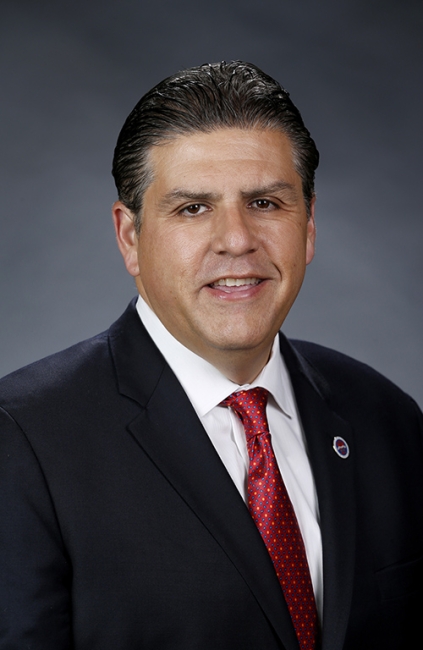You have /5 articles left.
Sign up for a free account or log in.

Joseph I. Castro will be the next chancellor of the California State University system.
Courtesy of the California State University system
Minutes after being named the next chancellor of the California State University system Wednesday, Joseph I. Castro appeared at a virtual Board of Trustees meeting and thanked his mother, who was watching from Hanford, Calif., in the San Joaquin Valley.
He grew emotional for a moment.
“I’m the son of a single mom, so she sacrificed a lot for me -- and so did my grandparents,” Castro said in an interview later in the day. “Sorry, I’m getting choked up again now, but it’s on days like this when I think about the sacrifices they made for me.”
Castro’s grandparents were immigrant farmworkers from Mexico. His mother worked as a beautician to support her family. Castro would become the first in his family to graduate from a university before going on to earn a Ph.D. and eventually becoming president of Cal State’s university in Fresno in 2013, where he remains today.
So after he was publicly named the next chancellor of Cal State, the sprawling 23-campus, 482,000-student system, Castro’s thoughts returned for a moment to the path his family traveled over the last century.
“From starting out in tents here 100 years ago,” he said. “That was how my family started out. In tents. To today.”
Castro’s coming chancellorship is a watershed moment for Cal State, which touts itself as the largest four-year higher education system in the country. He’ll be the first California native and the first Mexican American to hold the position.
It’s similar in significance to Castro’s leadership at Fresno State. The university is located in that same San Joaquin Valley, a region noted for its agricultural production but also high levels of poverty.
“When I started here, I was the first president born in California and the first from this region,” Castro said. “The fact that I was Latino was also important. But probably the most important thing was knowing a Hanford boy is our president. They loved that. I hope California is happy today to have a California boy leading.”
Castro sees higher education as both professional and personal work. It is also likely to be challenging work for him in the coming months and years.
Castro is slated to take over a Cal State system that has been led since 2012 by Timothy P. White, who is retiring after eight years that include notable successes boosting graduation rates and hiring diverse campus presidents. The system is holding classes primarily online in this year's fall semester because of the coronavirus pandemic and plans to do the same in the spring.
It has long recorded high levels of deferred facilities maintenance. Public funding for education is under pressure in California, where recessions typically cut deeply into budgets. Further, the system has a strong faculty union that less than two hours after Castro’s name was announced issued a list of 10 bullet points urging him to take certain actions.
Faculty members were hopeful for his tenure. There is every reason to believe Castro could be a good chancellor, said Thomas Holyoke, professor in the political science department at Fresno State and chair of the university’s Academic Senate.
“I think he is aware that he is coming to the system at a tough time,” Holyoke said. “The State of California decided that funding the public university system maybe is not a top priority in a COVID world. We’ve all been taking cuts, and it could be worse, for all we know. He’s going to have to manage that.”
Continuity Versus Change
The next Cal State chancellor is in a unique position between continuity and change. Castro was one of the first presidents appointed by the system’s current chancellor, White. He says he wants to build on White’s tenure and names as one of his top priorities a key effort to increase graduation rates instituted under White. But he also says changes will be necessary to adapt to a world forever changed by the coronavirus pandemic.
Since 2015, the system has been operating under an effort called the Graduation Initiative 2025, which aims to boost graduation rates, eliminate equity gaps in who earns degrees and position the system to produce graduates meeting the state’s workforce needs. The initiative remains a key priority, Castro said. To support those efforts, he’ll seek public and private funding and try to mobilize alumni.
At the same time, changes driven by COVID-19 have stimulated innovation in teaching and learning that will change what faculty members and students can do and which classes are best delivered in person or online.
“The CSU will look different,” Castro said. “Post-COVID, it will be more of a hybrid approach is my sense. But it will really be about how the faculty feel. I’ve seen them get inspired by that.”
White himself has talked about the need for the system to change in the future. The system needs to follow a consistent vision and mission while finding new innovations, he said in a January interview.
“Find policies or innovations that I couldn’t come up with,” he said at the time. “If it stayed the same, I’d be sad, actually.”
White announced last fall that he would be retiring. He initially planned to leave in June but delayed his departure because of the pandemic. During Wednesday’s Board of Trustees meeting, he kept his remarks short, congratulating Castro and offering him support in the coming months and weeks. Castro is slated to take over Jan. 4.
Cal State benefited from keeping White as its leader in the early days of the pandemic, said Lillian Kimbell, the system’s board chair. White was able to make informed, authoritative decisions such as moving most classes online for the fall and spring semesters.
“It was not an easy decision, and a lot of people were critical,” Kimbell said. “He knew it was the right thing to do. He has a science background, and he is always very clear about it: it’s the science and the right thing to do.”
Cal State’s search process changed significantly in the nearly year’s time since White announced he would be retiring.
The search essentially came to a halt because of the pandemic, Kimbell said.
“And the whole world changed, and we started looking again, and we started reassessing the candidates,” she said.
Faculty leaders and Castro himself also nodded to a search changed by COVID. Holyoke at Fresno State remembers Castro essentially taking himself out of the running for the chancellorship last year. Castro said the pandemic prompted him to consider the position.
“I was inspired by the COVID situation to pursue the search, and I was invited to jump in,” he said. “I believe in the direction we’re heading, and I know this is a challenging period. But leadership matters, and I thought it was important.”
Challenges for Leadership
No shortage of challenges await the chancellor-in-waiting.
While Cal State was among the first and most prominent systems of higher education to announce plans for primarily online learning this fall -- and again for the spring -- the percentage of students living on campus varies between institutions. So too do enrollment trends amid the crisis. Managing an eventual return to in-person instruction will be a logistical and potentially political challenge.
As will navigating tensions around an ethnic studies course requirement put in place by the state’s Legislature. Debate over ethnic studies and social justice general education requirements stretches back years at Cal State and includes a disagreement over system requirements and a requirement already in place at Cal State Northridge. Proposals to change mathematics admissions requirements have also been a major point of contention.
Finances are top of mind for Kimbell, the system board chair.
“We rely so much on personal income tax,” she said. “That goes up. That goes down. It’s really maddening, to be unable to plan things.”
The California Faculty Association identified several other issues. In a news release welcoming Castro, it called on him to protect the rights of undocumented students, respect academic freedom, work with unionized employees instead of against them and fill funding holes with Cal State financial reserves instead of tuition increases, job cuts or service cuts, among other things.
Castro has been accessible to faculty members, Holyoke said. When Holyoke first became chair of the university’s Academic Senate, Castro provided his phone number. The two meet regularly, and when Castro attends Academic Senate meetings, he takes questions and criticisms. Castro seems to have a genuine interest in shared governance, Holyoke said.
“He never brushes us off,” Holyoke said. “I get the impression he has instructed the senior administrators to also be very responsive to faculty needs. I can contact all the vice presidents and usually get a response within an hour.”
Fresno State’s budget has been one relatively small point of concern over the years, according to Holyoke. Faculty members wish the university had built deeper reserves than it currently has to help it navigate a financial downturn like the one currently unfolding.
The university has also drawn attention for dicey issues of freedom of speech and academic freedom in the era of the new culture wars. In one 2017 case, the university alerted federal authorities after a professor sent several controversial tweets including “Trump must hang.” At the time, Castro issued a statement saying the inclusion of violence and threatening language was inconsistent with the university’s core values.
In another case, Castro criticized inflammatory tweets from a professor in the wake of former first lady Barbara Bush’s death.
Both faculty members remained employed at Fresno.
Over all, Holyoke believes Castro could be a good system chancellor.
“He is a good listener,” Holyoke said. “He does, I think, genuinely make every attempt to try to reach out and listen to everybody who’s got something to say to him, and he’s thoughtful.”
Cal State has yet to announce an interim appointment to lead Fresno State after Castro becomes chancellor. A national search is expected to eventually lead to a permanent replacement.
Looking Forward
The pandemic has taught Castro not to harden his view on many matters, he said. He deeply values institutional mission and vision but believes certain ideas that might seem unreasonable one day could become very reasonable the next.
He expects to lean on his deep knowledge of California higher education and government. Before coming to Cal State, he was in the University of California system for 23 years, most recently as vice chancellor of student academic affairs at UC San Francisco.
Castro is close with Eloy Oakley, chancellor of the California Community Colleges system. And as he puts it, many of the people in the state capital, Sacramento, might have been students when he was assistant dean of public policy at UC Berkeley in the 1990s.
“Those are all assets in leading this complex university system,” he said. “Over time, we need to strengthen this ecosystem so that it better supports our students from all different backgrounds.”
At Fresno State, Castro enjoyed being in the San Joaquin Valley, near home. The night before he was announced as Cal State’s next chancellor, he had dinner with his mother.
“I wasn’t sure if we were going to be able to eat if I told her at the beginning of the meal,” he said. “So I told her at the end. She was concerned about me leaving.”
Then he transitioned from the personal anecdote to how it fuels professional work.
“I found that with all presidents, there is a powerful story,” he said. “We all have powerful stories, and each of them has a story. This work is personal and professional. That’s how I felt since I’ve been in higher education.”








